|
Why Is It That STOP Signs Are Red? Automobiles have been in use since the late 19th Century. Road signs are not that old. In the early days of automobiles, they shared the road with bicycles and horses, and everyone on the road had to beware of everything all the time. Although doing so is generally accepted as an excellent thing to do while traveling on a road, it wasn't until automobiles had been on roads for a time that road signs telling drivers what to do appeared. 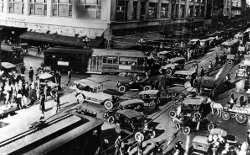
One of the most famous road signs is the STOP sign. It is universally seen today as white capital letters on a red background, all painted on an octagonal sign. But the shape of the sign and the color of the sign and the letters are innovations not present at the beginning. The brainchild of the STOP sign and of other road signs was William Phelps Eno. He never learned to drive (preferring the comfort and safety of being on horseback), but he helped revolutionize the way that other people drove. 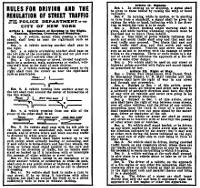
Born into a wealthy New England family, he made a name for himself in New York City. Long the country's largest city, New York was home to many streets, many drivers, many pedestrians, many horses (both bearing riders and leading carts and carriages), and many other things. In a 1900 issue of Rider and Driver magazine, Eno wrote an article titled "Reforming Our Street Traffic Urgently Needed." Among his proposals in that article was the idea that intersections should feature stop signs, so that drivers, in particular, would put safety first and stop their vehicles to see if a hazard was imminent. The first rules of the road appeared in 1909; the first manual of police traffic regulations appeared a decade afterward. The first STOP sign appeared in 1915, in Detroit, home to the automobile industry. This sign was neither red nor octagonal; rather, the sign was black lettering on a white background. 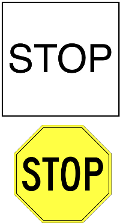
In 1923, engineers from the Mississippi Valley Assocation of State HIgh Departments published a set of rankings of sign shapes. The idea was to rank sign shapes by degree of caution. As the theory went, the more sides a sign had, the more danger that suggested. A circular shape, for example, was recommended for railroad crossings because a circle has an infinite number of sides. So, the circle was at the top of the "danger rankings." Second on that list was the octagon, with its eight sides. A warning sign was suggested to have three sides, or the shape of a diamond, or upside down triangle. Signs having a square or rectangular shape were to display information. As more and more states had more and more drivers (and more people traveled from one town to the next and one state to the next), the need for universal rules for the shape and color road signs grew. In 1935, the first national standards for road appeared, in the form of the Manual on Uniform Traffic Control Devices. Still, though, the STOP sign was not red. In this version, the word STOP was in black and the sign itself was yellow. 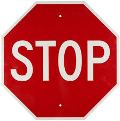
It wasn't until 1954 that the current combination of white letters on a red sign took hold. The idea was that the color red, more than any color, signified danger. As well, red is a color that can be seen from very far away, moreso than other colors. This made it all the more attractive for the designers of road signs. According to one source, it wasn't until that time that scientists developed a reflective material in the color red that would prove durable. 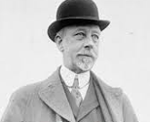
Eno, meanwhile, has come to be known as the "Father of Traffic Safety," not only for inventing the STOP sign but also for creating one-way streets, traffic circles, the pedestrian crosswalk, and pedestrian safety islands. He also came up with the idea of the rotary traffic circle, which is still in use today at some of the world's busiest intersections, including New York City's Columbus Circle, Paris's Arc de Triomphe, and London's Piccadilly Circus. More information on him is available at the Washington, D.C.-based Eno Center for Transportation. Have a suggestion for this feature? Email Dave. |
Social Studies for Kids |





